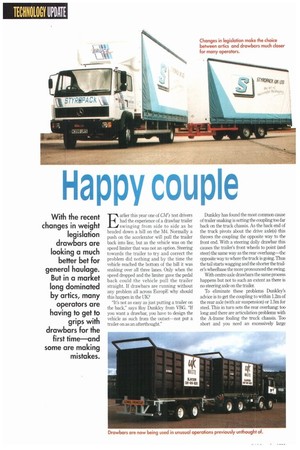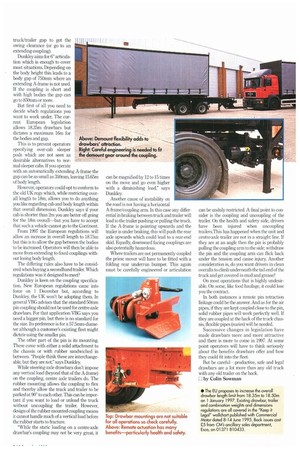Happy couple
Page 40

Page 41

If you've noticed an error in this article please click here to report it so we can fix it.
With the recent changes in weight legislation drawbars are looking a much better bet for general haulage. But in a market long dominated by artics, many operators are having to get to grips with drawbars for the first time—and some are making mistakes. FI arlier this year one of GM's test drivers had the experience of a drawbar trailer swinging from side to side as he headed down a hill on the M4. Normally a push on the accelerator will pull the trailer back into line, but as the vehicle was on the speed limiter that was not an option. Steering towards the trailer to try and correct the problem did nothing and by the time the vehicle reached the bottom of the hill it was snaking over all three lanes. Only when the speed dropped and the limiter gave the pedal back could the vehicle pull the trailer straight. If drawbars are running without any problem all across EuropE why should this happen in the UK?
"It's not as easy as just putting a trailer on the back," says Roy Dunkley from VBG. "If you want a drawbar, you have to design the vehicle as such from the outset—not put a trailer on as an afterthought." Durildey has found the most common cause of trailer snaking is setting the coupling too far back on the truck chassis. As the back end of the truck pivots about the drive axle(s) this throws the coupling the opposite way to the front end. With a steering dolly drawbar this causes the trailer's front wheels to point (and steer) the same way as the rear overhang—the opposite way to where the truck is going. Thus the tail starts wagging and the shorter the trailer's wheelbase the more pronounced the swing.
With centre-axle drawbars the same process happens but not to such an extent as there is no steering axle on the trailer.
To eliminate these problems Dunkley's advice is to get the coupling to within 1.2m of the rear axle (with air suspension) or 1.5m for steel. This in turn sets the rear overhang: too long and there are articulation problems with the A-frame fouling the truck chassis. Too short and you need an excessively large truck/trailer gap to get the swing clearance (or go to an extending coupling).
Dunkley aims for 60 articulation which is enough to cover most situations. Depending on the body height this leads to a body gap of 750min where an extending A-frame is not used. If the coupling is short and with high bodies the gap can go to 850mm or more.
But first of all you need to decide which regulations you want to work under. The current European legislation allows 1825m drawbars but dictates a maximum 16m for the bodies and gap.
This is to prevent operators specifying over-cab sleeper pods which are not seen as desirable alternatives to normal sleeper cabs. If you operate with an automatically extending A-frame the gap can be as small as 350mm, leaving 15.65m of body length.
However, operators could Opt to conform to the old UK regs which, while restricting overall length to 18m, allows you to do anything YOU like regarding cab and body length within that overall dimension. Dunkley says if your cab is shorter than 2m you are better off going for the 18m overall—but you have to accept that such a vehicle cannot go to the Continent.
From 1997 the European regulations will allow an increase in overall length to 18.75m but this is to allow the gap between the bodies to be increased Operators will then be able to move from extending to fixed couplings without losing body length.
The differing rules also have to be considered when buying a secondhand trailer. Which regulations was it designed to meet?
Dunkley is keen on the coupling specification. New European regulations came into force on 1 December but, according to Dunkley, the UK won't be adopting them. In general VI3G advises that the standard 50inm pin coupling should not be used for centre-axle drawbars. For that application VBG says you need a bigger pin, but there is no standard for the size. Its preference is for a 57.5mm-diameter although a customer's existing fleet might dictate using the smaller pin.
The other part of the pin is its mounting. These come with either a solid attachment to the chassis or with rubber sandwiched in between. "People think these are interchangeable, but they are not," says Dunkley.
While steering-axle drawbars don't impose any vertical load (beyond that of the A-frame) on the coupling, centre axle trailers do. The rubber mounting allows the coupling to flex and thereby allow the truck and trailer to be parked at 900 to each other. This can be important if you want to load or unload the truck without uncoupling the trailer. However, design of the rubber-mounted coupling means it cannot handle much of a vertical load before the rubber starts to fracture.
"While the static loading on a centre-axle drawbar's coupling may not be very great, it can be magnified by 12 to 15 times on the move and go even higher with a diminishing load," says Dunkley.
Another cause of instability on the road is not having a horizontal A-frame/coupling arm. In this case any differential in braking between truck and trailer will lead to the trailer pushing or pulling the truck. If the A-frame is pointing upwards and the trailer is under braking, this will push the rear axle upwards which could lead to a rear-end skid. Equally, downward facing couplings are also potentially hazardous.
Where trailers are not permanently coupled the prime mover will have to be fitted with a folding rear underrun bumper. This again must be carefully engineered or articulation can be unduly restricted. A final point to consider is the coupling and uncoupling of the trailer. On the health and safety side, drivers have been injured when uncoupling trailers.This has happened when the unit and centre-axle trailer are not in a straight line. If they are at an angle then the pin is probably pulling the coupling arm to the side; withdraw the pin and the coupling arm can flick back under the tension and cause injury. Another consideration is, do you want drivers in clean overalls to climb underneath the tail end of the truck and get covered in mud and grease?
On most operations that is highly undesirable. On some, like food haulage, it could lose you the contract.
In both instances a remote pin retraction linkage could be the answer. And as for the air pipes, if they are kept coupled close to the pin, solid rubber pipes will work perfectly well. If they are coupled at the back of the truck chassis, flexible pipes (suzies) will be needed.
Successive changes in legislation have made drawbars more and more attractive and there is more to come in 1997. At some point operators will have to think seriously about the benefits drawbars offer and how they could fit into the fleet.
But be careful—productive, safe and legal drawbars are a lot more than any old truck with any old trailer on the back.
Li by Colin Sowman • The Eli proposes to increase the overall drawbar length limit from 18.35m to 18.50m on 1 January 1997. Existing drawbar, trailer and combinafion weights and dimensions regulations are all covered in the "Keep it Legal' wallchart published with Commercial Motor dated 8-14 June 1995. Back issues cost £5 from CM'S ancillary soles department, Esco, on 01371 810433.












































































































